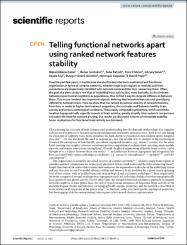| dc.contributor.author | Zanin, Massimiliano | |
| dc.contributor.author | Güntekin, Bahar | |
| dc.contributor.author | Aktürk, Tuba | |
| dc.contributor.author | Yıldırım, Ebru | |
| dc.contributor.author | Yener, Görsev | |
| dc.contributor.author | Kıyı, İlayda | |
| dc.contributor.author | Hünerli Gündüz, Duygu | |
| dc.contributor.author | Sequeira, Henrique | |
| dc.contributor.author | Papo, David | |
| dc.date.accessioned | 2022-02-25T08:06:45Z | |
| dc.date.available | 2022-02-25T08:06:45Z | |
| dc.date.issued | 2022 | en_US |
| dc.identifier.citation | Zanin, M., Güntekin, B., Aktürk, T., Yıldırım, E., Yener, G., Kıyı, İ. ... Papo, D. (2022). Telling functional networks apart using ranked network features stability. Scientific Reports, 12(1), 2562-2562. http://doi.org/10.1038/s41598-022-06497-w | en_US |
| dc.identifier.issn | 2045-2322 | |
| dc.identifier.uri | http://doi.org/10.1038/s41598-022-06497-w | |
| dc.identifier.uri | https://hdl.handle.net/20.500.12511/9005 | |
| dc.description.abstract | Over the past few years, it has become standard to describe brain anatomical and functional organisation in terms of complex networks, wherein single brain regions or modules and their connections are respectively identified with network nodes and the links connecting them. Often, the goal of a given study is not that of modelling brain activity but, more basically, to discriminate between experimental conditions or populations, thus to find a way to compute differences between them. This in turn involves two important aspects: defining discriminative features and quantifying differences between them. Here we show that the ranked dynamical stability of network features, from links or nodes to higher-level network properties, discriminates well between healthy brain activity and various pathological conditions. These easily computable properties, which constitute local but topographically aspecific aspects of brain activity, greatly simplify inter-network comparisons and spare the need for network pruning. Our results are discussed in terms of microstate stability. Some implications for functional brain activity are discussed. | en_US |
| dc.description.sponsorship | Turkiye Bilimsel ve Teknolojik Arastirma Kurumu (TUBITAK)-218S314 | en_US |
| dc.description.sponsorship | French Ministry of Foreign Affairs PHC-Bosphore Program | en_US |
| dc.description.sponsorship | European Research Council (ERC) | en_US |
| dc.description.sponsorship | Spanish State Research Agency, through the Severo Ochoa and Maria de Maeztu Program for Centers and Units of Excellence in RD | en_US |
| dc.language.iso | eng | en_US |
| dc.publisher | NLM (Medline) | en_US |
| dc.rights | info:eu-repo/semantics/openAccess | en_US |
| dc.rights | Attribution 4.0 International | * |
| dc.rights.uri | https://creativecommons.org/licenses/by/4.0/ | * |
| dc.subject | Network Features | en_US |
| dc.subject | Functional Networks | en_US |
| dc.subject | Ranked | en_US |
| dc.title | Telling functional networks apart using ranked network features stability | en_US |
| dc.type | article | en_US |
| dc.relation.ispartof | Scientific Reports | en_US |
| dc.department | İstanbul Medipol Üniversitesi, Tıp Fakültesi, Temel Tıp Bilimleri Bölümü, Biyofizik Ana Bilim Dalı | en_US |
| dc.department | İstanbul Medipol Üniversitesi, Rektörlük, Sağlık Bilim ve Teknolojileri Araştırma Enstitüsü | en_US |
| dc.department | İstanbul Medipol Üniversitesi, İMÜ Meslek Yüksekokulu, Elektronörofizyoloji Ana Bilim Dalı | en_US |
| dc.authorid | 0000-0002-0860-0524 | en_US |
| dc.authorid | 0000-0002-7555-3801 | en_US |
| dc.authorid | 0000-0002-7715-3035 | en_US |
| dc.identifier.volume | 12 | en_US |
| dc.identifier.issue | 1 | en_US |
| dc.identifier.startpage | 2562 | en_US |
| dc.identifier.endpage | 2562 | en_US |
| dc.relation.publicationcategory | Makale - Uluslararası Hakemli Dergi - Kurum Öğretim Elemanı | en_US |
| dc.identifier.doi | 10.1038/s41598-022-06497-w | en_US |
| dc.institutionauthor | Güntekin, Bahar | |
| dc.institutionauthor | Aktürk, Tuba | |
| dc.institutionauthor | Yıldırım, Ebru | |
| dc.identifier.wosquality | Q1 | en_US |
| dc.identifier.wos | 000756701900003 | en_US |
| dc.identifier.scopus | 2-s2.0-85124680483 | en_US |
| dc.identifier.pmid | 35169227 | en_US |
| dc.identifier.scopusquality | Q1 | en_US |



















